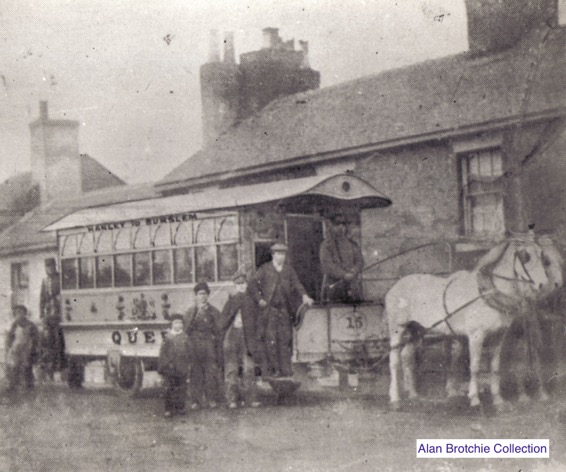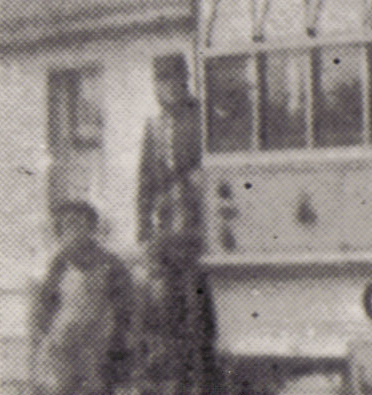Staffordshire Potteries Street Railway
History
The street tramway between Hanley and Burslem, which was owned and operated by the Staffordshire Potteries Street Railway Company Limited, was one of the earliest in the country, opening on the 13th January 1862. The tramway was promoted by American entrepreneur George Francis Train, the man behind the first true street tramway in the British Isles (Birkenhead Street Railway Company), as well as three separate lines in London (Marble Arch Street Railway; Surrey Side Street Railway; Westminster Street Railway) and one in Darlington (Darlington Street Railway). The rails used on all these lines were 'step' rails, the inside edges of which were lower than the main road surface (or sometimes with the outside ends proud of the road surface if poorly laid), a design which inevitably invoked opposition from the influential carriage-owning classes, especially in London, where Train seems to have taken personal pleasure in aggravating the establishment; as a consequence, all three of his London lines were to close within 15 months of opening.
The Potteries line was standard gauge and 1.75 miles in length, running northwards from Foundry Street in Hanley, along Waterloo Road to the Market Place in Burslem. Whilst the company had originally envisaged building a system extending northwards through Tunstall to Goldenhill, as well as southeastwards through Fenton to Longton, lack of capital meant that the line between Burslem and Hanley was all that was ever built. The line was built without parliamentary authority, but by virtue of way-leave agreements with the turnpike authorities along whose roads the tramway ran.
The company probably operated the service itself for a short while (this is not wholly clear), but by 1863 it was being leased to a Mr Edward Brassington, and from March 1864, a Mr George B Bradford (initially for five years). It is entirely possible that other contractors were used for short periods, or that the company took over itself at various junctures, but if so, these changes have eluded the historical record.
The tramway was of course plagued by the same problems as all Train's other 'step' rail concerns, but unlike most of the others (the exception being the Birkenhead Street Railway), the issues were relatively quickly remedied — between October 1863 and the end of 1864 — by relaying the entire tramway with new grooved rails. Beyond that, the tramway appears to have led a relatively uneventful though profitable existence, carrying 300,000 passengers in its last year of independent operation.
The SPSRCo eventually sold out to a new company — the North Staffordshire Tramways Company Ltd — which had obtained powers (and capital), to build a steam tramway system linking many of the towns that the SPSRCo had originally hoped to serve. The NSTCo purchased the SPSRCo on the 17th March 1880, and continued to run horse-drawn services via the incumbent lessee, Mr Bradford, who was also chairman of the SPSRCo. Services probably ceased over the old SPSRCo tracks on the 28th September 1881, services commencing the following day over the new 4ft-gauge line that had been laid alongside; these services were initially horse-drawn as the NSTCo had yet to acquire powers to use steam traction on this section. Steam services are thought to have started in mid-to-late June 1882.
Uniforms
Despite its early date (1862), and provincial location, a reasonably good photograph of a Staffordshire Potteries Street Railway horse tram and crew has survived. This photo reveals that conductors wore single-breasted jackets with metal buttons and tall kepi-style caps; the latter possibly carrying a large metal badge. The situation with drivers is less clear, though the photo below seems to suggest that an overcoat or coachman's coat was worn, along with a tall kepi-style cap. In fact, staff working all of Train's street tramways are known to have worn uniforms (likened by contemporary commentators to those worn by the Rifle Brigade, and possibly of Oxford Grey), so the photographic evidence is entirely consistent with Train's approach to staff uniforms on the other systems he was involved in.
Further reading
For a detailed history of early street railways, including the Staffordshire Potteries, see: 'Pioneers of the Street Railway in the USA, Street Tramways in the UK…and elsewhere' by John R Stevens and Alan W Brotchie; Stenlake Publishing Ltd (2014).
Images
Horse tram drivers and conductors
The crew of the tramcar 'Queen' pose for the camera along with a host of individuals in work attire, suggesting that they may be stable/workshop staff. The photo is undated, but given the pristine condition of the tram, very probably taken in the early 1860s. It is unclear what the '15' denotes, possibly a licence, as the SPSRCo only possessed a maximum of three vehicles at any one time.
A blow-up of the above photo showing the conductor, who is clearly wearing a military-style uniform with a tall kepi-style cap.